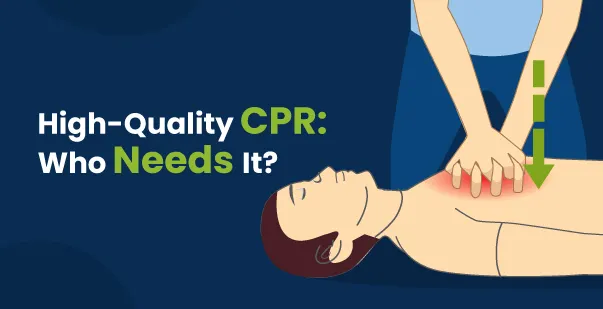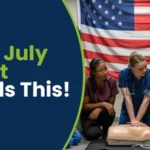Table of Contents:
- Introduction
- What Is High-Quality CPR?
- Difference between Normal CPR and High-quality CPR
- Victims Who Require High-Quality CPR
- Contraindications of Victims Requiring High-Quality CPR
- High-Quality CPR: Saving Victims with Precision Skills
Introduction
When a heart fails to function properly, victims experience sudden collapse with or without respiratory arrest. The proper functioning of the heart could be compromised in situations like traumatic car accidents, physical trauma, or drowning. Such emergencies are not uncommon.
Cardiopulmonary resuscitation, or CPR, is a life-saving skill that educates the public on how to perform resuscitation during emergencies when advanced medical support is not immediately available. Training in high-quality adult CPR includes learning precise techniques that significantly increase the chances of survival compared to basic CPR. Continue reading to learn more about high-quality adult CPR.
What Is High-Quality CPR?
High-quality CPR is a type of cardiopulmonary resuscitation performed by trained paramedics and nurses. It is administered when a victim’s survival is threatened by sudden collapse, cardiac arrest, or a similar emergency. In such situations, basic CPR provided by a bystander might not be adequate to resuscitate the victim. Once paramedics or trained rescuers arrive, they immediately begin performing high-quality CPR on the victim.
The key features of a high-quality CPR include:
Compression Site, Rate, and Depth
Compressions should be delivered over the breastbone, just below the nipples. High-quality adult CPR includes a precise compression rate of 100-120 per minute. Each compression should be 2 to 2.4 inches (5-6 cm) deep. To prevent injury, compressions exceeding 2.4 inches must be avoided.
Chest Compression Fraction and Chest Recoil
The compressions given to a victim who requires high-quality CPR should have a chest compression fraction equal to or greater than 80%. While the compression rate should be between 100-120 per minute, full chest recoil must be maintained to allow the heart to refill with blood.
High-quality CPR emphasizes minimal interruptions. Interruptions between chest compressions that last more than 10 seconds should be avoided.
Rescue Breathing and Ventilation
A rescue breath should be delivered every 6 seconds without using advanced airway devices. Excessive ventilation should be avoided, as it can reduce cardiac output and potentially result in failed resuscitation.
Difference Between Basic CPR and High-Quality CPR
One of the main distinctions between basic CPR and high-quality CPR lies in the method used, the level of precision, and the circumstances under which they are performed. Basic CPR is a cardiopulmonary resuscitation attempted by any individual or bystander using the hands-alone method. Under necessary circumstances, high-quality CPR for an adult includes performing resuscitation as a combination of CPR and an automated external defibrillator (AED).
Basic CPR focuses on maintaining a compression-to-ventilation ratio of 30:2 in adults and a 15:2 ratio in children. High-quality adult CPR includes performing precisely a 2-2.4 inch deep compression at a rate of 100-120 compressions per minute.
In short, a bystander provides basic CPR when a victim requires CPR before the arrival of a well-trained paramedic arrives. High-quality CPR is delivered to high-risk patients by trained professional rescuers, such as nurses and paramedics.
Read More: Chance of Survival with CPR: What You Need to Know in an Emergency
Victims Who Require High-Quality CPR
CPR should only be given to an individual who has collapsed and is not breathing; more specifically, it should be basic CPR. High-quality CPR is provided in specific situations when a victim meets certain criteria.
A few scenarios in which a victim requires high-quality CPR are listed below:
Cardiac Arrest Victims
Cardiac arrest is one of the most common situations where victims which requires high-quality CPR are found. A cardiac arrest is the sudden stoppage of the heart’s functioning, resulting in the interruption and stoppage of blood flow to the brain and other vital organs. Performing high-quality CPR on these victims helps restore and maintain blood circulation and oxygen delivery until the patient receives advanced medical support.
Hypothermia Victims
Hypothermia is a condition where the body’s temperature falls extremely low. Such a dangerously low body temperature slows down the heart rate, resulting in cardiac arrest. In such conditions, reestablishing a normal body temperature through thorough rewarming is necessary. Otherwise, all efforts at high-quality CPR may be futile, resulting in death or permanent damage to the victim.
Electrocution Victims
When a victim undergoes electrocution, it results in cardiac arrest due to disruption of the heart’s electrical activity. Carrying out high-quality adult CPR here helps in the restoration of normal heart rhythm and maintaining blood flow to vital organs.
Choking Victims
In choking victims, complete airway obstruction prevents oxygen from reaching the lungs. If the obstruction is not relieved quickly, the victim may become unresponsive and go into cardiac arrest. In such a situation in which an adult requires high-quality CPR, it helps dislodge the obstruction and restore breathing.
Drug Overdose Victims
Another case where victims require which an adult requires high-quality CPR is drug overuse. Drug overdoses, especially with opioids, can cause respiratory arrest and, subsequently, cardiac arrest. High-quality CPR in such victims helps maintain blood flow and oxygenation until the effects of the overdose are reversed with an antidote or naloxone.
Trauma Victims
Severe trauma, such as that resulting from a car accident or dangerous fall, can lead to cardiac arrest due to significant blood loss or injury to the heart. In such cases, the relevance of carrying out high-quality adult CPR includes sustaining circulation and oxygenation. By improving the chances of survival and recovery, CPR minimizes neurological adverse effects in victims.
Respiratory Arrest Victims
Patients with asthma attacks or severe allergies, when exposed to vulnerable situations, have a high chance of undergoing respiratory arrest. This results in the stoppage of breathing, even when the heart might still beat for a few minutes. However, if high-quality CPR is not provided in this case, the victim may fall into cardiac arrest due to a lack of cardiac output.
Drowning Victims
Submersion in water causes respiratory arrest in drowning victims, resulting in the stoppage of breathing. High-quality CPR with rescue breaths is essential to restore oxygenation and circulation in the victim’s body, thereby preventing brain damage and increasing the chances of survival.
Read More: First Aid for a Person Saved from Drowning
Contraindications of Victims Requiring High-Quality CPR
Here are a few cases where CPR is contraindicated or should be avoided, even if they might seem like a situation in which the victim requires high-quality CPR.
Terminally Ill and DNR Individuals
An individual labeled as DNR (Do Not Resuscitate) should never be given CPR, even if it results in their death. The same applies to patients with terminal illnesses who have consented not to receive CPR under any circumstances.
Victims with Signs of Irreversible Death
A victim who has collapsed at an unknown time should not be given CPR if signs of irreversible death are present. If evidence of death, such as rigor mortis, has set in, avoid administering CPR under all circumstances.
Compromised Safety of Resuscitating Environment and Rescuer
If a victim requiring high-quality CPR is found in an unsafe environment, all attempts at resuscitation should be avoided. Do not provide high-quality CPR unless the victim has been moved to the nearest safe location. If the environment poses a risk to the rescuers’ lives, it is permissible to delay CPR until safety is ensured. Additionally, avoid providing excessive ventilation to any victim, as it can reduce cardiac output and intra-arterial pressure.
Being well-versed and adequately trained in CPR training can help prevent such mistakes. Professional training equips individuals with the knowledge required to provide high-quality CPR and a better understanding of which adult victim requires high-quality CPR.
High-Quality CPR: Saving Victims with Precision Skills
Adopting proper resuscitation methods significantly increases the chances of survival of the victim. This also maximizes the chances of recovery for victims during emergencies like cardiac arrest, drowning, choking, drug overdose, etc. Performing high-quality adult CPR includes adhering to recommended guidelines. Sticking to precise metrics and proper practices enables trained rescuers to manage situations in which the victim requires high-quality CPR. Hence, attaining such training increases the scope of survival and recovery, thereby preventing permanent neurological damage and reducing the impact of damage.
References:
- https://medlineplus.gov/ency/presentations/100219_2.htm
- https://pmc.ncbi.nlm.nih.gov/articles/PMC7176711/
- https://heartstartcpr.net/
- https://medlineplus.gov/cpr.html
- https://pmc.ncbi.nlm.nih.gov/articles/PMC6944876/
- https://pmc.ncbi.nlm.nih.gov/articles/PMC7063209/
- https://jamanetwork.com/journals/jamainternalmedicine/fullarticle/414609







